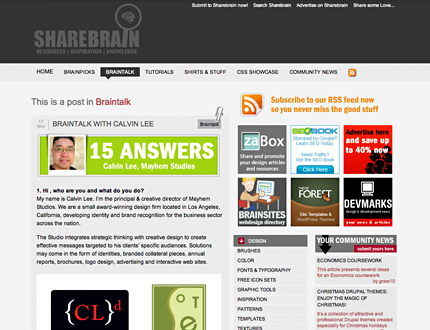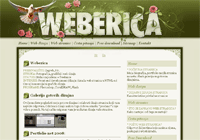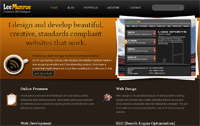
There’s been a LOT of buzz lately over Itty Biz’s latest product, Online Business School.
If you don’t know Naomi Dunford, she runs Itty Biz, which offers consulting to small and home business owners. It’s through the Itty Biz blog that I started gaining more knowledge as to how to run my own web design business full time – especially in terms of marketing and self-promotion.
My Own Personal Experience With Itty Biz
It wasn’t long before I hired Naomi myself – you can read more on my Taking the Freelance Plunge post, as well as on this home business success story over on Itty Biz.
Long story short, I knew that I wanted to leave my day job to run my own business full time. I had the talent as a web designer, but not necessarily the sales or marketing skills to make it a viable option.
I knew I needed some expert advice, so I hired Itty Biz back in January. We had an amazing consultation that set so many things in motion! I can’t even begin to express how motivational my consultations with Naomi were!
She offered me amazing advice and support, and I credit her with being a big part of the reason I was able to take the “plunge” a full 6 months earlier than planned. Of course determination and talent played the largest role, but Naomi’s helpful advice helped steer me in the right direction.
More Than Just Consulting
Itty Biz has since released several information products – including SEO School: How to Become an SEO Ninja. Last week, after an enormous amount of work Naomi and her husband Jamie have launched their next big project:

On The Fence
I admit, I was on the fence about buying this product for some time. As a client of Naomi’s, I know how great her advice is. This chick knows what she’s talking about – no doubt there!
But, I’ll be honest – Online Business School is not cheap. It’s currently $197 which for some people – myself included – is a bit of money. If you are thinking of buying, though – don’t wait too long, as this is just a limited price!
There are a LOT of big name bloggers who are marketing this product. Once the first 2,000 orders have been made, Online Business School will be going up to full price – $397.
Pretty good marketing technique I must say. More proof that Itty Biz knows their stuff, LOL. It worked on me, anyway, because I knew I wanted to get it, and wanted to get it at half price, so I made a purchase of my own over the weekend – and am so glad I did!
What Exactly Is Online Business School?
To get straight to the point, here’s what’s covered in the program…
The course consists of 6 modules – each consisting of an mp3 audio file, pdf ebook and mov video screencast. The modules focus on each of the 6 income streams to diversify your income:
- Affiliate Marketing
- Coaching and Consulting
- Ebooks and Downloads
- Niche Sites
- Physical Products
- Service Business
The pdf and audio files essentially cover the same material (the pdfs are transcripts of the audio). I find it helpful that they include both formats for several reasons:
- you can listen to the audio and follow along in the pdf at the same time (double reinforcement so to speak)
- if you learn better through reading, you can just read the pdf
- if you learn better by having someone talk to you, or if you want to pop this on your iPod while driving to work or running errands, you can listen along
The video is an added component from Naomi’s husband, Jamie. Different than the audio, these basically serve as companion pieces as they go further into some of the topics that Naomi covers in the audio portions. The videos consist of screencasts with examples of some of the site referenced in the audio, etc.
- the PDF files each run 9-10 pages long
- the audio files each run 35-40 minutes long
- the video files each run 20-30 minutes long
With 6 modules, it’s clear that they do not skimp on content!
Yeah, But What’s The Point?
The point of Online Business School is to teach you of the 6 different methods of earning income. With today’s economy being as down in the dumps as it is, it’s important not to rely on JUST one source of income alone.
Naomi wrote a post for the sales page titled “Why We’re Broke and How To Fix It” – the point to bring home here is that your family is depending on you. If you are depending on only one source of income – and something happens to that source – well, then what?

Say Goodbye to the Feast or Famine Cycle
As a freelancer or small business owner, you are probably all too familiar with the term “Feast vs Famine.” I touched upon this in the Get Clients Now series, which I want to start up again next year.
The goal of any small business owner – especially in a service business – is to sell your services and get a steady range of work. The operative word here being STEADY. Going solo or being self-employed, you no longer have that steady paycheck coming in once every two weeks. Nope. It’s now all up to you to secure your next client.
For most of us, there is an endless cycle of either having too much work, or not enough. In a service based industry, you typically start off by marketing your butt off to get some clients… when your marketing efforts pay off, you end up being slammed with work. That’s GREAT!
But the problem here is that you’re so busy doing work for your own clients that you end up not having any free time to continue marketing yourself. So a month or two go buy where you feverishly complete work for your new clients and get PAID!
But then what?
As you reach the end of these new client deadlines, you realize that you haven’t spent any time marketing yourself this last month or two. You’ve received your last payments for these jobs and think…
What the heck am I going to do NEXT month?
That’s where you’re potentially screwed. No new work other than the odd small job here or there. So what do you do? Market yourself like crazy again! You spend another month with hardly any income – instead you spend all of your time focusing on self-promotion.
That ends up being a financially difficult month as you scrape what money you had, possibly diving into savings – aka Famine. Until your promotional efforts pay off and you are once again slammed with work – aka Feast.
It’s an endless cycle – rinse and repeat.

Diversify Your Income
The theory to Online Business School is that you are playing with your family’s future and well being by putting all of your eggs in one basket. You go through the “Feast vs Famine” cycle, you get stressed on the slow months because ALL you have is your online service business, or your consulting business or product sales – whatever it is that you “do”
Enter the additional forms of income streams!
If you have several income streams going at once, you will always have SOMETHING coming in. Whether that be affiliate commissions, product sales, etc. you’ll have something to fall back on when your primary source of income slows down. And yes, it is inevitable that you will always have both busy and slow times regardless of what type of business you run.
One of the income streams covered in the course is ebooks and downloads. As a web designer – especially one who specializes in designing and developing custom WordPress Themes – I’ve toyed with the idea of releasing my own premium WordPress themes, but have yet to act on it.
Online Business School really hit home the point that I should have this in place already! For the slow months while I’m focusing my energies on self promotion, I could be making both affiliate and ebook/download sales as a backup. If I have a steady stream of 3-4 income sources going at the same time, I’ll never be completely stuck with NO income when one of the streams temporarily slows down.
I’ll be honest that I’m actually surprised by how much of a fire Online Business School has lit under me! There are ideas that I’ve tinkered with for months now, but haven’t taken any steps towards implementing.
But after listening to the program, I’ve actually started to schedule myself in – as though I were my own client – so that I can implement some of these new income streams. With the current economic crisis – for the well being of our own families – to safeguard our futures – how could we not?
It’s All Inter-Changeable
Another benefit of Online Business School? It’s not as transparent as it seems by looking at the list of what’s included.
When I first heard of the course, my first thought was…
Well I have a service based business. That’s all I need!
Why can’t she just sell them individually so I don’t have to shell out $200 for the whole thing?
Well first of all, that defeats the entire purpose of the course, as it’s goal is to teach you how to diversify your income. Yes, it’ll help give you techniques to make your existing method of income better. But, it’ll also teach you how to incorporate NEW income streams.
But better yet, in almost every case, EACH and EVERY module of the course has something you can incorporate to a different area.
For example…
- I’m primarily interested in the Service Business section. Upon listening to the Coaching and Consulting section – I realize that much of the advice still applies to my existing service based business.
- I figured the Physical Product section would be entirely pointless to me. Nope – this module touches on Search Engine Optimization and Ad Words (something I had not previously used and quite frankly didn’t know much about).
- The Coaching and Consulting module delves into issues of Pricing your service and Sales. Regardless of what kind of business you have – you do need to deal with pricing and sales.
I could go on, but long story short, I’m sure that you’ll find at least one item to take away from each and every one of the modules that can be applied to your business.
Working On My Own Income Streams
With the “How To” information from Online Business School, I’ve made it a priority to carve out some time to update my own site and service offerings. I learned some great ‘tricks’ from the Service Business module that I can use almost immediately to update on my own web site.
For the web designers reading – and I know a lot of you are web designers – there is a lot of good info for us in the course, especially in the Service Business module!

Still Not Convinced? Check Out the FREE Preview
If you’re still not sure if Online Business School is for you, go check out the (very long) sales page over on Itty Biz. There is a lot of FREE content on the site, including a few free video and audio pieces. Including an interview where Naomi mentions one of my own clients, Nicole from Pick Nick’s Brain as an example of a Consulting business!
There is also a video (pictured above) where Naomi explains how she made $176,000 in the first part of 2008. I can only hope to bring in that much income one day!
My Own Recommendation?
Yes, I do recommend Online Business School (and not just because I’m an affiliate – this is a completely honest and from-the-heart review!) Since I’ve worked directly with Naomi in the past, I know her, and I know first hand that she offers some kick ass advice.
And with this course, it is advice you have in video and audio files that you can replay whenever you want. Listen to them all now… or focus on just one aspect now, and come back to another in a month or two. It’s all there whenever you need.

Bonus Material
As if the course itself wasn’t enough, I received an email from Itty Biz the day after I purchased, saying that my bonus material was ready. Bonus material? Huh?
YES! Tons of great bonuses! I’m truly amazed at the support Naomi has received for Online Business School – many of the big bloggers out there have contributed their own products to be part of the bonus material.
Just for starters…
- Emergency Money Plan – Naomi Dunford from Itty Biz
(a shorter, bonus audio for the course, which gives suggestions on how to make quick money if you are in a pinch)
-
30 Hours a Day – Dave Navarro from Rock Your Day
(the first THREE sections of the program – both audio and PDF’s included)
- SEO Nomicon: SEO Magic for WordPress – Michael Martine of Remarkablogger
(this is an advance copy – it hasn’t even officially been launched yet! – both audio and PDF included)
- Writing for the Web – James Chartrand and Harrison McLeod at Men with Pens
(PDF ebook)
Plus many more – all-in-all, there are 9 bonus downloads!

Money Back Guarantee
And the best part of the deal? Itty Biz is also also offering a money back guarantee in case you don’t find Online Business School to be helpful at all.
Even better than a refund, if you have questions and don’t understand some aspect of the program – Naomi will personally coach you. The value of personal coaching is much greater than a refund, so how could you possibly say no to that?
I understand that you might be reluctant, which is why I’m giving you the same 100% money back, zero pain in the ass factor guarantee that I give for all my IttyBiz stuff. Except it’s going to be even better.
Because income streams are scary and because you might think you can’t do it and because I know you’re probably worried and hopeful at the same time, here’s what we’re going to do.
If, having gone through Online Business School, you are not absolutely certain you can create a better living on this crazy thing we call the World Wide Web, you have two choices.
I’ll give you your money back without being a pain in the ass about it. OR I’ll personally coach you through it so that you have a plan of action that will work for you.

Don’t Miss Out – Get 50% OFF Now!
If you’ve been considering purchasing Online Business School, but have been on the fence like I was – I do recommend you get your hands on a copy as soon as possible, while it’s still available at the discounted rate of 50% OFF.
There is an introductory rate of 50% OFF the first 2,000 copies sold. But with the “big” bloggers promoting the course on their own blogs, you can bet the the discounted rate of 50% OFF will NOT last long – and trust me, you do not want to miss out on this!
You owe it to yourself to help safeguard your own future income! Get Online Business School today!


































